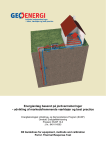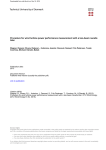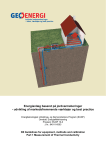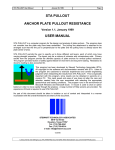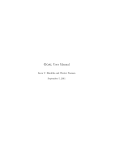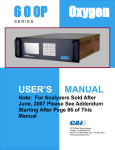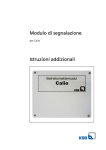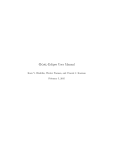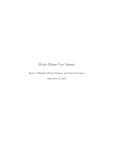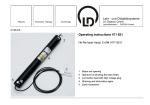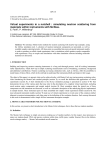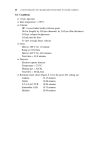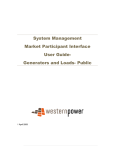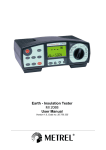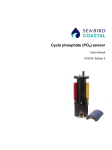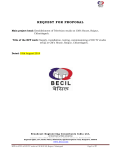Download Publisher version
Transcript
Downloaded from orbit.dtu.dk on: Dec 17, 2015 Summary of the steps involved in the calibration of a Spinner anemometer Demurtas, Giorgio; Friis Pedersen, Troels Publication date: 2014 Document Version Publisher final version (usually the publisher pdf) Link to publication Citation (APA): Demurtas, G., & Friis Pedersen, T. (2014). Summary of the steps involved in the calibration of a Spinner anemometer. DTU Wind Energy. (DTU Wind Energy I; No. 0364). General rights Copyright and moral rights for the publications made accessible in the public portal are retained by the authors and/or other copyright owners and it is a condition of accessing publications that users recognise and abide by the legal requirements associated with these rights. • Users may download and print one copy of any publication from the public portal for the purpose of private study or research. • You may not further distribute the material or use it for any profit-making activity or commercial gain • You may freely distribute the URL identifying the publication in the public portal ? If you believe that this document breaches copyright please contact us providing details, and we will remove access to the work immediately and investigate your claim. Summary of the steps involved in the calibration of a Spinner anemometer Authors: Giorgio Demurtas, Troels F. Pedersen DTU Wind Energy Report I-0364 November 2014 Authors: Giorgio Demurtas, Troels F. Pedersen DTU Wind Energy Report I-0364 Title: Summary of the steps involved in the calibration of a Spinner anemometer November 2014 Institute: Wind Energy Division Summary (max 2000 char.): The present report is a practical guide that summarizes the steps involved in the calibration of a spinner anemometer. For each step is briefly recalled the objective, which document describes the procedure to use, and what actions must follow the calibration. Contract no.: EUDP-2009-I SpinnerFarm project j.nr. 64009-0103 Sponsorship: Energiteknologisk Udviklings Og Demonstrations Program Front page: ISBN: Pages: Fourteen Tables: Five References: Seven Technical University of Denmark DTU Wind Energy Frederiksborgvej 399 Building 125 4000 Roskilde www.vindenergi.dtu.dk Preface Over the past two years the topic of the calibration of the spinner anemometer has been investigated in detail at DTU Wind Energy. A number of procedures has been developed, tested and published in journals and reports. In order to facilitate Romo Wind (licensor of the DTU patent of the spinner anemometer) into use this scientific results, the present document summarizes the purpose of each calibration step, which documents refer to, and how to apply in practice the calibration outcomes. Risø Campus, November 2014 Giorgio Demurtas, Troels F. Pedersen Summary The present report is a practical guide that summarizes the steps involved in the calibration of a spinner anemometer. For each step is briefly recalled the objective, which document describes the procedure to use, and what actions must follow the calibration. DTU Wind Energy Report I-0364 1 Contents 1 Introduction 3 2 Calibration sequence 2.1 Zero wind calibration . . . . . . . . . . . . . . . . . . . 2.1.1 Objective . . . . . . . . . . . . . . . . . . . . . 2.1.2 Procedure . . . . . . . . . . . . . . . . . . . . . 2.1.3 Post calibration actions . . . . . . . . . . . . . . 2.2 Wind tunnel calibration of the sensors . . . . . . . . . . 2.2.1 Objective . . . . . . . . . . . . . . . . . . . . . 2.2.2 Procedure . . . . . . . . . . . . . . . . . . . . . 2.2.3 Post calibration actions . . . . . . . . . . . . . . 2.3 Internal calibration . . . . . . . . . . . . . . . . . . . . . 2.3.1 Objective . . . . . . . . . . . . . . . . . . . . . 2.3.2 Procedure . . . . . . . . . . . . . . . . . . . . . 2.3.3 Post calibration actions . . . . . . . . . . . . . . 2.4 Calibration of inflow angle measurements (kα constant) . 2.4.1 Objective . . . . . . . . . . . . . . . . . . . . . 2.4.2 Procedure . . . . . . . . . . . . . . . . . . . . . 2.4.3 Post calibration actions . . . . . . . . . . . . . . 2.5 Calibration of the wind speed measurement (k1 constant) 2.5.1 Objective . . . . . . . . . . . . . . . . . . . . . 2.5.2 Procedure . . . . . . . . . . . . . . . . . . . . . 2.5.3 Post calibration actions . . . . . . . . . . . . . . . . . . . . . . . . . . . . . . . . . . . . . . . . . . . . . . . . . . . . . . . . . . . . . . . . . . . . . . . . . . . . . . . . . . . . . . . . . . . . . . . . . . . . . . . . . . . . . . . . . . . . . . . . . . . . . . . . . . . . . . . . . . . . . . . . . . . . . . . . . . . . . . . . . . . . . . . . . . . . . . . . . . . . . . . . . . . . . . . . . . . . . . . . . . . . . . . . . . . . . . . . . . . . . . . . . . . . . . . . . . . . . . . . . . . . . . . . . . . . . . . . . . . . . . . . . . . . . . . . . . . . . . . . . . . . . . . . . . . . . . . . . . . . . . . . . . . . . . . . . . 3 4 4 4 4 4 4 4 6 6 6 6 6 6 6 7 7 7 7 7 7 3 Determination of the NTF (Nacelle transfer function) 7 4 Annex A: Spinner anemometer sonic sensor calibration procedure 4.1 Post calibration action . . . . . . . . . . . . . . . . . . . . . . . . . . . . . . . . . . 4.2 Uncertainty . . . . . . . . . . . . . . . . . . . . . . . . . . . . . . . . . . . . . . . 8 9 9 5 Annex B: Mounting plate for sonic sensor wind tunnel calibration 6 Annex C: Database organization 6.1 Objective . . . . . . . . . . . . . . . 6.2 Traceability of the calibration values 6.3 Traceability of installations . . . . . 6.4 Data table . . . . . . . . . . . . . . 6.5 Unit of measurements . . . . . . . . DTU Wind Energy Report I-0364 . . . . . . . . . . . . . . . . . . . . . . . . . . . . . . . . . . . . . . . . . . . . . . . . . . . . . . . . . . . . . . . . . . . . . . . . . . . . . . . . 10 . . . . . . . . . . . . . . . . . . . . . . . . . . . . . . . . . . . . . . . . . . . . . . . . . . 12 12 12 12 13 13 2 1 Introduction The scope of the present report is to briefly clarify the sequence of the steps involved in the calibration of a spinner anemometer, and which document describe the procedure to use in each step. Note that for best precision it is recommended that the calibration values are inserted in the conversion box of the spinner anemometer as soon as they are known. Although it is possible to correct measurements to any new calibration value, the post calibration of averaged measurements will introduce an error [1]. It is recommended to record in the database calibrated measurements, and, keep track of the calibration values applied to each corresponding measurement period. 2 Calibration sequence IEC 61400-12-2 Calibration of the spinner anemometer The calibration of the spinner anemometer is more complex than for a regular anemometer. The calibration should follow the following steps (figure 1), which ensures traceability and accurate measurements of both angles and velocities. Zero wind calibration of individual sonic sensors O1, O2, O3, O4, O5, O6 Wind tunnel calibration of individual sonic sensors E1, E2, E3, F1, F2, F3 (Mounting on the spinner) Internal calibration of the spinner anemometer J1, J2, J3, I1, I2, I3 Calibration for inflow angle measuremens K1=k1,d , K2=k1,d · kα Calibration for wind speed measurements K1=k1 , K2=k1 · kα Nacelle Transfer Function (NTF) Look-up table Free wind speed Figure 1: Steps needed to calibrate a spinner anemometer Once the spinner anemometer is calibrated, in order to calculate the free wind speed one should determine the Nacelle transfer function (NTF), as it is normally done for a nacelle anemometer, following the method described in the standard IEC 61400-12-2 [2]. DTU Wind Energy Report I-0364 3 2.1 2.1.1 Zero wind calibration Objective The objective of the zero wind calibration is to ensure a stable zero reading in the output. The microprocessor of the spinner anemometer conversion box uses the temperature and the path length provided by the user to compute the exact path length and some constants to take into account the delays in the transducers and in the reading circuit. 2.1.2 Procedure The procedure to execute the zero wind calibration is described in the Metek manual [3], and comprises the following steps: • sensor path length is measured and inserted as P1, P2, P3. • the temperature is inserted as T1, T2, T3. • At the end of the internal routine (launched with C2, C2, C3 for each sensor respectively) the conversion box saves the new values of the (read only) offset parameters O1, O2, O3, O4, O5, O6. 2.1.3 Post calibration actions After the calibration is extremely important to handle the sensors with care, so that the sensor geometry (path length) is not changed. 2.2 2.2.1 Wind tunnel calibration of the sensors Objective The objective of calibration of individual sonic sensors is to calibrate the wind speed measurements by the sonic sensors V1, V2 and V3. 2.2.2 Procedure The procedure is described in annex 4 and 5. Each sonic sensor is tested in the wind tunnel individually. A calibration certificate is released for each sonic sensor. An example of the certificate is shown in figure 2. DTU Wind Energy Report I-0364 4 Figure 2: Example certificate The calibration equation specified in the certificate has the form: Vt = Acal · Vn,meas + Bcal (1) Where Vt is the wind tunnel velocity Vt,meas is the velocity read by the conversion box in the sensor path. The most important numbers to use from the certificate are: • Acal (the slope coefficient of the calibration equation) • Bcal (the offset of the calibration equation) • φ (the tilt angle of the sensor respect to the mounting plate) Figure 3: View of sonic sensor and wind speed components DTU Wind Energy Report I-0364 5 The tunnel wind speed projected on the sensor path is: Vn = Vt · cos(φ) (2) Multiplying equation 1 for cos(φ) we obtain: Vn = Acal · cos(φ) · Vn,meas + Bcal · cos(φ) (3) The spinner anemometer algorithm calculates V1 as: Vn = E · Vn,meas + F (4) Where during calibration E = 1, F = some constant value dependent on the result of the zero wind calibration. By combining equation 3 and 4 we obtain that: 2.2.3 E = Acal · cos(φ) (5) F = Bcal · cos(φ) (6) Post calibration actions E1, E2, E3, F1, F2, F3 must be set in the conversion box accordingly. B should be close to zero. 2.3 2.3.1 Internal calibration Objective This calibration is necessary to normalize the three sensor paths to each other. The calibration constants k1 and k2 are adjusted for each individual sonic sensor, such that they deliver the same average value during one rotation. This is to take into account mounting errors at each of the sonic sensors and to take into account of non-symmetry of the spinner. 2.3.2 Procedure The procedure should be launched in good wind conditions (stable wind direction, wind speed above 6 m/s approximately). Follow the Metek Manual [3]. Theory is given in chapter 2.3 Development of internal calibration method, in [4]. 2.3.3 Post calibration actions Check the values I1, I2, I3, J1, J2, J3 according to the manual [3]. 2.4 2.4.1 Calibration of inflow angle measurements (kα constant) Objective The objective of calibration of the kα constant is to calibrate the spinner anemometer for angular measurements. DTU Wind Energy Report I-0364 6 2.4.2 Procedure This is done by manually yawing the wind turbine (in good wind conditions) in and out from the wind several times, and comparing the variations of the yaw position with the variations of the yaw misalignment read by the spinner anemometer. The procedure should be launched in good wind conditions. Follow the DTU Wind Energy Report I-0305 [5]. Theory and recommendations are given in [1]. 2.4.3 Post calibration actions Set the K2 constant in the spinner anemometer conversion box equal to k2 = k1,d · kα . Leave k1 = k1,d . Remember that kα = kα,d · Fα . 2.5 Calibration of the wind speed measurement (k1 constant) 2.5.1 Objective The objective of calibration of the k1 constant is to calibrate the spinner anemometer for wind speed measurements. 2.5.2 Procedure Follow the method described in [6] (based on measurements or CFD). Theory is given in [1]. 2.5.3 Post calibration actions • Set the K1 constant in the spinner anemometer conversion box equal to k1 . • Change the K2 constant to: k2 = kα · k1 . 3 Determination of the NTF (Nacelle transfer function) The nacelle transfer function serves to calculate the free wind speed as a function of the wind speed measurement at the spinner. To calculate the NTF follow the method described in the standard IEC 61400-12-2 [2], Annex D and C. DTU Wind Energy Report I-0364 7 4 Annex A: Spinner anemometer sonic sensor calibration procedure Spinner anemometer sonic sensors shall be calibrated in a wind tunnel with the following procedure: 1. The calibration shall be undertaken according to IEC 61400-12-1 Annex F with following changes. 2. Performance tests with the use of a spinner anemometer shall be made with one to three sonic sensors (each a 1D wind speed sensor) mounted on the spinner. All sonic sensors used in the performance test shall be calibrated. 3. The objective of the wind tunnel calibration is to calibrate the sonic sensor path wind speed at the actual path elevation angle of the sonic sensor when mounted on a flat plate 4. All sonic sensors of a spinner anemometer shall be calibrated individually in the wind tunnel. 5. The sonic sensor shall be mounted on a flat plate. The plate shall be large enough to ensure that the flow in the sonic sensor path is not significantly influenced by the flow distortion of mounting supports or fittings or cabling underneath the plate. The plate shall also be short enough that the boundary layer development on the plate do not influence on the lower sonic sensor head of the sonic sensor. The plate should also not have sharp corners that develop tip vortices or flow distortion that influences on the sonic sensor path or the pitot tube. 6. The mounting plate shall be mounted in the wind tunnel parallel to the flow. The orientation of the plate in the wind tunnel may be horizontal or vertical. The plate shall have a leading edge profile that ensures that no separation occurs, and that the flow over the flat plate under the sonic sensor path describes a standard flat plate boundary layer development. The requirements to such a flat plate may be met with the flat plate description in Annex 5. (Annex 5 describes a mounting plate that can be mounted on a supporting tube similar to cup anemometers). 7. The sonic sensor (covering the sonic sensor path, the sonic sensor heads and the structure supporting the sonic sensor heads) shall be mounted within a test section area, where flow uniformity has been verified, equivalent to the area allowed for cup anemometers. The distance between the reference pitot tube and the sonic sensor path should be similar to the distance to a cup anemometer. 8. A calibration factor kc shall be determined for the relation between the reference pitot tube and the position of the center of the sonic sensor path while the flat plate is mounted in the tunnel without a sonic sensor mounted, but with mounting holes covered e.g. with tape. The sonic sensor cable shall be installed such that no significant influence to the flow will occur at the reference pitot tube and at the sonic sensor (e.g. underneath the plate and in downwind direction going to the bottom/side of the tunnel) 9. The sonic sensor on the plate shall be oriented in line with the wind tunnel flow. A deviation of the plate with the flow direction shall be less than or equal to 0.1◦ . 10. The sonic sensor path angle (angle of the line between the sonic sensor heads and the mounting plate) shall be measured after mounting of the sonic sensor on the plate prior to the test. The accuracy of the angular measurement must be better than or equal to 0.1◦ . DTU Wind Energy Report I-0364 8 11. Zero wind calibration of the sonic sensor must be made before mounting on the plate; however this is not part of the wind tunnel calibration. 12. During the calibration, the operation mode of the spinner anemometer shall be set to a mode that includes the output of the wind speed of the actual sonic sensor. 13. A calibration certificate shall be issued for each sonic sensor. In addition to the requirements for a cup anemometer calibration certificate the certificate shall document: (a) ID of sonic sensor and ID of spinner anemometer box (b) Documentation of setup of the sonic sensor (c) Sonic sensor path angle relative to flat mounting plate measured while mounted on the mounting plate (d) Operation mode of the spinner anemometer 4.1 Post calibration action The sonic sensor path wind speed is calibrated in the wind tunnel at an inclined sonic sensor angle, but otherwise with a similar set-up and calibration certificate as for cup anemometers. However, the calibration result does not refer to the sonic sensor path. When converting the wind tunnel calibration result from the calibration certificate to the sonic sensor path the calibration expression shall take account of the actual measured sonic sensor path angle φ in the following way: Vn = Acal · cos(φ) · Vn,meas + Bcal · cos(φ) (7) Where Vn Vn,meas Acal Bcal φ 4.2 is is is is is the the the the the calibrated wind speed along the sonic sensor path measured wind speed by the sonic sensor calibration line gain value from the calibration certificate calibration line offset value from the calibration certificate sonic sensor path angle measured when mounted on the mounting plate Uncertainty The uncertainty on the calibrated wind speed along the sonic sensor path is influenced by the uncertainty of the wind tunnel wind speed and on the measured sonic sensor path angle. The relation is: Vn = Vt · cos(φ) (8) Where Vt is the wind tunnel wind speed. The combined uncertainty is: 2 σc (Vn ) = ∂(Vt cosφ) ∂Vt 2 2 σ(Vt ) + ∂(Vt cosφ) ∂φ 2 σ(φ)2 = cos2 φ · σ(Vt )2 + Vt2 sin2 φ · σ(φ)2 (9) Where σ(Vt ) σ(φ) is the standard uncertainty on the tunnel wind speed from the calibration certificate is the standard uncertainty on the measured sonic sensor path angle DTU Wind Energy Report I-0364 9 The uncertainty on the sonic sensor path angle may be determined by the required measurement accuracy of the flat plate relative to the flow direction ± 0.1◦ and the measured sonic sensor path to flat plate angle, also ± 0.1◦ . Assuming a rectangular uncertainty distribution for the combined angular measurement we get: 0.2◦ σ(φ) = √ = 0.12◦ (10) 3 5 Annex B: Mounting plate for sonic sensor wind tunnel calibration A mounting plate that satisfies the requirements for calibration is shown in figure 4. The plate should have a circular shape in the upwind direction. The projection of the point in the middle of the sonic path on the plate should be the center of the circular shape and the radius should be 150mm. Downwind of this circle center the plate should be rectangular with a width of 300mm and a length of 200mm. The mounting hole for the fitting of the sonic center should fit in the middle of the width of the rectangular part and match the projected middle of the sonic path on the plate. A tube fitting on the bottom side of the plate should be positioned at the center of the circular part. The tube fitting should match a mounting tube with a diameter of maximum 30mm (25mm shown in figure 1). The plate shall be made of a hard and stiff material. Plate thickness should be maximum 5mm. The leading edge should be super-elliptic with an exponent of 3 and a plate thickness to length ratio of 1:3 [7]. Alternatively, the leading edge should be sharp and beveled with a 1:3 cutoff on the lower side. DTU Wind Energy Report I-0364 10 Figure 4: Mounting plate and setup for calibration of a spinner anemometer sonic sensor in wind tunnel. Location of the calibration factor kc is indicated with a cross in the upper left figure in the middle of the sonic sensor path. DTU Wind Energy Report I-0364 11 6 6.1 Annex C: Database organization Objective The objective of this section is to give some hints regarding the database organization, in order to ensure traceability between measurements, instruments, calibration certificates and local settings. The database should be accessible from an interface with login (user-name and password) in order for the system to store in the log-tables the changes made by the users. 6.2 Traceability of the calibration values The database should contain a table that couple each spinner anemometer conversion box with its current settings. The structure of the table is suggested as follows. The first column is the serial number of the spinner anemometer conversion box. The column ”since” has a date format that tells since when the calibration coefficients applies. The table contains current values, while the old calibration values can be recovered from the table ”log calibrations”. Spinner sn .. . A1 .. . A2 .. . A3 .. . B1 .. . B2 .. . B3 .. . phi1 .. . phi2 .. . phi3 .. . k1 .. . k2 .. . since .. . Table 1: Example table ”calibrations” To keep track of the changes, the web interface used to change the values in the table ”calibrations” should log the changes. By combining the informations contained in such table it is possible to print a text in a web page in a user friendly manner, for example: ”17/11/2014: k1 changed from 1.000 to 0.714 by giod”. date .. . user .. . Spinner sn .. . parameter .. . old .. . new .. . Table 2: Example table ”log calibrations” 6.3 Traceability of installations The database should contain clear informations regarding the coupling between spinner anemometers and turbines. If a spinner anemometer is moved to another turbine, the table should be updated and the modifications saved in the table ”log installations”. Windfarm id .. . Windfarm name .. . turbine id .. . Spinner sn .. . since .. . Table 3: Example table ”installations” DTU Wind Energy Report I-0364 12 6.4 Data table For ease in the organization of the measurements, the database shall contain calibrated measurements. Each spinner anemometer installation shall have a database table named with its unique identification number (for example spin xxxx for 10 minute averaged measurements and spin xxxx 10hz for 10 Hz sampled data). An example of the table is given in table 4. Qvpc is the maximum value of the qvpc values in the 10 minutes period. Pe is the electric power output of the wind turbine, Pbar the barometric pressure. Statistical values such as the standard deviation, maximum and minimum can be saved using a suffix to make the column name, for example Pe std, Pe max, Pe min respectively. Alternatively, a separate table could be used to save the statistical values (named for example spin xxx std). The drawback of this second solution is that will be necessary to merge the measurements for the analysis. t .. . Uhor .. . gamma .. . beta .. . Uhor std .. . gamma std .. . beta std .. . qvpc .. . Pe .. . Pbar .. . Temp1 .. . ... .. . Table 4: Example table ”spin xxx” To avoid doubts, the data recorded for calibration purposes shall be recorded in a separated table (with suffix cal, for example spin xxxx calka, spin xxxx calk1 ). Remember: it is good to have good calibrated measurements in the database. 6.5 Unit of measurements When not specified differently, the unit of measurements of the data in the database shall be: Symbol ◦ kW m/s ◦C Name degrees kilowatt meters per second degrees Celsius Description Angles Active power Wind speed Temperature Table 5: Unit of measurements DTU Wind Energy Report I-0364 13 References [1] Calibration of a spinner anemometer for yaw misalignment measurements. T.F. Pedersen, G. Demurtas, F. Zahle (September 2014) - Wind Energy 2014, Wiley. [2] IEC standard 61400-12-2: Power performance of electricity producing wind turbines based on nacelle anemometry, Annex D and C. [3] Spinner Anemometer, User Manual, Metek version 9.27-3, 20.08.2012 or later version. [4] Improvement of Wind Farm Performance by Means of Spinner Anemometry. DTU Wind Energy report E-0040. Troels Friis Pedersen, Giorgio Demurtas, Julia Gottschall, Jrgen Højstrup, Jesper Degn Nielsen, Wolfgang Christiansen, Gnther Weich, Anders Sommer, Jesper Runge Kristoffersen. December 2013. [5] Calibration of a spinner anemometer for flow angle measurements by use of wind turbine yawing. DTU Wind Energy report I-0305. G. Demurtas, T.F. Pedersen. September 2014. [6] Calibration of a spinner anemometer for wind speed measurements (submitted for publication to Wind Energy, Wiley). G. Demurtas, T.F. Pedersen, F. Zahle. [7] Leading edge shape for flat plate boundary layer studies. Narasimha R, Prasad SN. DTU Wind Energy Report I-0364 14 DTU Wind Energy is a department of the Technical University of Denmark with a unique integration of research, education, innovation and public/private sector consulting in the field of wind energy. Our activities develop new opportunities and technology for the global and Danish exploitation of wind energy. Research focuses on key technical-scientific fields, which are central for the development, innovation and use of wind energy and provides the basis for advanced education at the education. We have more than 230 staff members of which approximately 60 are PhD students. Research is conducted within 9 research programmes or-ganized into three main topics: Wind energy systems, Wind turbine technology and Basics for wind energy. Technical University of Denmark DTU Vindenergi Frederiksborgvej 399 Building 118 4000 Roskilde Denmark Telefon 46 77 50 85 [email protected] www.vindenergi.dtu.dk


















